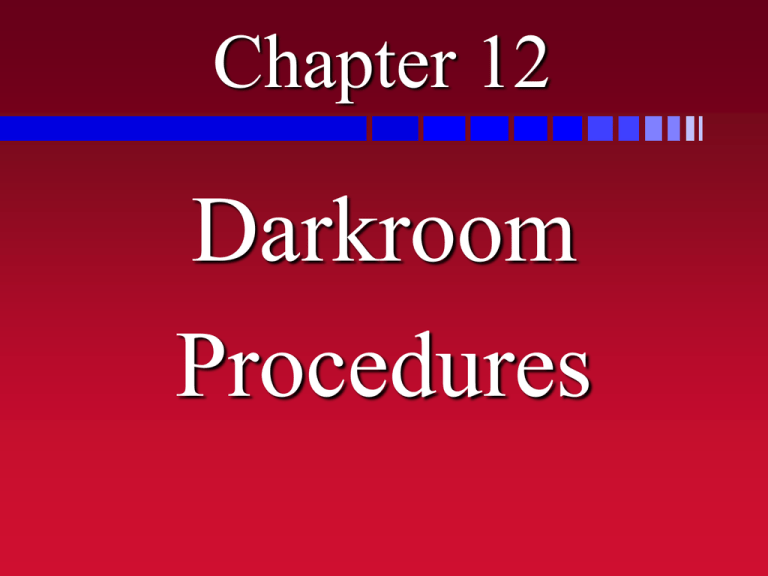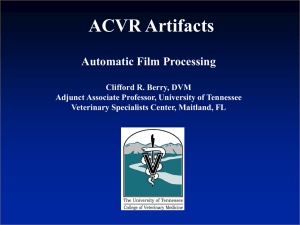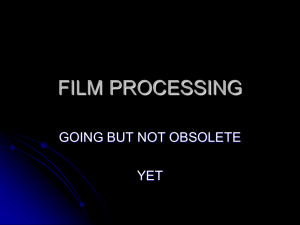Physics 12 - NYCC SP-01
advertisement

Chapter 12 Darkroom Procedures Darkroom Procedures To repeat what was previously said about the composition of x-ray film, it has a base of cellulose acetate covered on both sides with a sensitive emulsion of silver halides (silver bromide, chloride & iodide). Today plastic polyester is used. Darkroom Procedures When this emulsion is exposed to radiation or light (from screens or other sources) an unexplainable change takes place that cannot be seen. The change is produced in the physical & chemical structure of the emulsion. Darkroom Procedures The change produced on the emulsion depends upon the amount of x-ray & light reaching it. Since the body part being radiographed absorbs some of the radiation being directed at it, we can see that the amount reaching the screens & the film depends upon the intervening tissue. Darkroom Procedures For example, bone absorbs more x-ray & fewer rays get through to the film/crystals. Therefore, fewer crystals are activated. The areas outside the parts receive the total amount of radiation & in this area structural change is complete. The portion of the film under the lead marker (and any other structure that absorbs all the radiation) receives none & there is no structural change to the silver halide crystals. Darkroom Procedures The other tissue areas absorb the x-rays in varying degrees depending upon the thickness & density of the parts & thus the film & screens under these parts receive varying degrees of x-ray & the screens glow in varying degrees & thus the change in the emulsion varies from place to place. A Latent image is formed in this way. Darkroom Procedures We can therefore see that the latent image must be a complete one. The purpose of dark room procedures is to change the latent image to a photographic one. Film Processing Chemicals Various chemicals are used in the processing of the radiographic film. Of the ones discussed here, the developer & the fixer must be used; the developer replenisher, the fixer replenisher & the acid stop-bath may or may not be used. Film Processing Chemicals There are other chemicals used for special purposes (intensification of under-developed film, reduction of over-developed film), but they will not be discussed. Directions for their use will be found on the package. The Developer Developing is actually the reduction of the exposed silver halides to metallic or elemental silver (the converting of the latent image to a visible image). The developer causes a reaction of the silver halide crystals & thus makes them visible. The Developer This is done through a pair of redox reactions where an electron is made available to unite with a silver ion that has a single (+) charge (from light hitting the film), thus reducing the silver ion to metallic/elemental silver. The Developer Reducing Agents – change the exposed silver halides to black metallic silver; elon (for detail) is balanced with hydroquinone (for contrast). Accelerator/Activating – maintains the proper alkalinity for the developer to work & also swells the gelatin. Accelerating agents include sodium carbonate or sodium hydroxide. Prolonged exposure to these may result in dermatitis due to its alkalinity The Developer Preservative – prevents oxidation of the developing agents by having a greater affinity for O2 than the developing agents themselves. The preservative used is sodium sulfite. Restrainer – slows down the development rate in order to prevent fogging. Potassium bromide & potassium iodine are the agents used. The Developer Dissolving Agent – used is water. Hardening Agents – used in automatic processors & functions to prevent excessive emulsion swelling. These agents include gluteraldahyde. The Developer Replenisher In using the developer the bromide removed from the film builds up & acts as a restrainer for prolonged developing time. Developer replenisher, which is a supercharged developer with no restrainer, can be added to the developer tank to bring the solution up to a proper level while also bringing it back to its proper strength. The Acid Stop-Bath This is absent in all automatic processors as the rollers within the processor function to squeeze off the developer. In manual developing, the acid stop-bath can be used after the film leaves the developer to stop the development immediately. The Acid Stop-Bath It is a weak acetic acid solution that neutralizes the alkaline developer. Acid stop-bath is not usually used because it necessitates having an extra tank. The film is usually rinsed in the water tank to remove most of the developer before putting it into the fixer. The Fixer Fixation involves two separate processes: The “clearing” of the film of unexposed silver halide salts which are not affected by the developer &which would turn black if exposed to light (these have not been reduced by the developer). The “hardening” of the emulsion. The Fixer The darkroom lights may be turned on as soon as the film has cleared since there are than no light sensitive elements in the emulsion. Clearing Agent – removes the unexposed silver halide salts from the film (sodium thiosulfate, a.k.a. hypo). Most modern fixers use ammonium thiosulfate. The Fixer Hardener – reduces the swelling & softening of the emulsion produced by the alkaline developer & hardens it (potassium alum). Preservative – maintains proper acidity of the solution & prevents early breakdown of the clearing agent (sodium sulfite). The Fixer Acidifier – neutralizes the alkaline developer carried over & keeps the medium acid for the hardener to do a full job (acetic or sulfuric acid). Dissolving Agent – used is water. The Fixer In manual developing chrome alum may be used as a hardener instead of potassium alum. This makes the fixer opaque to light. Therefore, the lights may be turned on as soon as the film is put into the fixer with out harm. The Fixer Replenisher Replenisher for the fixer is available but care must be taken to remove enough of the old solution before adding the replenisher for solution carried out must be balanced by solutions carried in. Steps in Film Processing Before beginning to process film the developer & fixer should be stirred with separate paddles. The temperature should be as close to 680 as possible. Developing times & temperatures may vary. As a rule with increased temperature you decrease the developing time & vice versa. Steps in Film Processing The film is removed from the cassette & clipped into a film hanger. The cassette should be closed to avoid staining of the screens with solutions during processing. Steps in Film Processing The film is than passes through the following five steps (four with automatic processing): Developing Rinsing Fixing Washing Drying Steps in Film Processing Developing – developing of the film may be done by: 1) sight (under a safelight of course) 2) by time & temperature charts which are available. – The average time developing temp/time is 680 for 5 minutes. Steps in Film Processing Time & temperature is recommended because the opacity of the uncleared film & the length of time for the eye to accommodate to the darkness makes inspection of the film difficult & prolonged exposure to the safelight can fog the film. In either case the film should be agitated for the first few seconds in the developer to remove any air bubbles on the film surface that would restrict development in that area. Steps in Film Processing Rinsing – After development the film should be rinsed in clear water (running) for 30 to 45 seconds to remove as much of the developing chemicals as possible to stop development & prevent contamination of the fixer with alkaline developer. – An acid stop-bath may be used in place of the rinse, but in using either the film should be drained before putting it into the fixer. In automatic processing the rinsing stage is removed Steps in Film Processing Fixing – We have previously described the actions of the fixer as “clearing” & “hardening” of the emulsion. These two processes occur simultaneously but the latter takes approximately twice as long. – The clearing time is usually 3-4 minutes but the film is left in the fixer for 10 minutes for hardening. Steps in Film Processing Washing – The finished film should be composed of metallic silver embedded in gelatin & nothing else. The film must be thoroughly washed to remove all chemicals to prevent discoloration & fading of the image. – Films should be washed 15 minutes in clear running water, depending upon the rate of flow, temp., type of film used & the type of fixer used. Steps in Film Processing The longer the film spends in the fixer, the longer the wash time needed. This is a 1:2:3 ratio of developer to fixer to wash. Steps in Film Processing Drying The ideal situation for drying of x-ray film is a film drying box that combines a heating element with a circulating fan. It can dry in 15 minutes. Film will dry properly if hung in air for a longer period (1+ hours). A fan aimed at the edge of the film will speed up the process. Replenisher Method & Exhaustion Method Both the developer & the fixer may be either replenished to maintain the timing or used until exhausted by increasing the time element. Both methods are satisfactory but the replenisher method saves time, does not involve record keeping & is less expensive.







